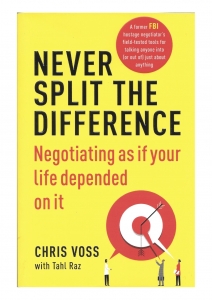The one sentence summary
Years of experience from the toughest negotiations in the world can help in business and life too.
WHAT THE BOOK SAYS 
- This is written by a former FBI negotiator and contains the nine principles he believes lead to successful negotiation.
- Be a mirror: repeat what they say to gain empathy, use silence to allow it to work, use the late night DJ voice to calm things down, and don’t make assumptions. Mirroring is also called
- Don’t feel their pain, label it: by using phrases such as “It seems like…”, “It sounds like…” and “It looks like…”
- Beware yes and master no: no usually means something else, such as I am not yet ready to agree, you are making me uncomfortable, or I don’t understand.
- Trigger the two words that transform any negotiation: “That’s right.”
- Bend their reality: make deadlines your ally, put the emphasis on fairness, anchor their emotions, and establish a range of options.
- Create the illusion of control: ask calibrated questions that start with “How” or “What”.
- Guarantee execution: you need the other person to say yes 3 times to guarantee it’s going to happen. There are three types of yes: counterfeit, confirmation and commitment.
- Bargain hard: when you do talk numbers, use odd ones – it makes it sound as though they are properly calculated.
- Find the black swan: something you know that they don’t, or discovering something about them that you didn’t know.
WHAT’S GOOD ABOUT IT
- At the heart of it all is tactical empathy – listening as a martial art, balancing emotional intelligence with active listening to get inside the mind of the other person.
- The many ways of expressing no include: “How am I supposed to do that?” (delivered deferentially as a plea for help); “You’re offer is very generous but I’m sorry it just doesn’t work me”; “I’m sorry but I just can’t do that.”
- Negotiating types:
Analyst: methodical, diligent, not in a rush (time = preparation)
Accommodator: takes time to build the relationship (time = relationship)
Assertive: getting it done more important than getting it right (time = money)
- The Ackerman model: set your target price; make your first offer 65% of it; make 2-3 more offers in increments such as 75/85/95; use empathy and different ways of saying no in the meanwhile; when calculating the final amount, use precise, non-round figures; at the end throw in a non-monetary item to show you are at your limit.
- Overall: use effective pauses, minimal encouragers such as yes, okay, and uh-huh, mirror, label, paraphrase and summarize.
WHAT YOU HAVE TO WATCH
- It contains some machismo from the world of hostage taking.
